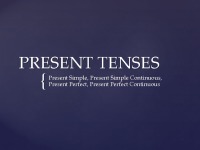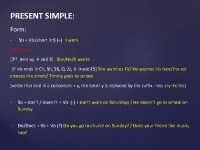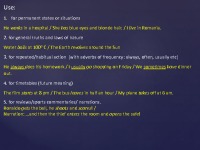English: Present Tenses Grammar Guides



Present tenses. Present Simple, Present Simple Continuous, Present Perfect, Present Perfect Continuous. Present simple form. Use for permanent. Present continuous form sb. Use For temporary situations She is working in Paris this week. Stative verbs Stative verbs express a permanent state and don’t usually have continuous forms. Present perfect form sb. Use 1. Recently completed actions He has just cut the grass. Present perfect continuous form. Use For actions started.
Present Simple, Present Simple Continuous, Present Perfect, Present Perfect Continuous.
PRESENT SIMPLE: Form: Sb + Vb (short inf) (+) I work Spelling ↓ [3rd pers sg → add S] She/He/It works [if Vb ends in Ch, Sh, SS, O, Zz, X →add ES] She watches TV/ He washes his face/the cat crosses the street/ Timmy goes to school [verbs that end in a consonant + y, the letter y is replaced by the suffix –ies: cry→cries] Sb + don’t / doesn’t + Vb (-) I don’t work on Saturdays / He doesn’t go to school on Sunday Do/Does + Sb + Vb (?) Do you go to church on Sunday? / Does your friend like music, too?
Use: for permanent states or situations He works in a hospital / She has blue eyes and blonde hair. / I live in Romania. 2. for general truths and laws of nature Water boils at 100⁰ C / The Earth revolves around the Sun 3. for repeated/habitual action {with adverbs of frequency: always, often, usually etc} He always does his homework / I usually go shopping on Friday / We sometimes have dinner out.
- Languages Presentations
- MS PowerPoint 347 KB
- 2020 m.
- English
- 11 pages (992 words)
- Gymnasium
- Ogustė

















